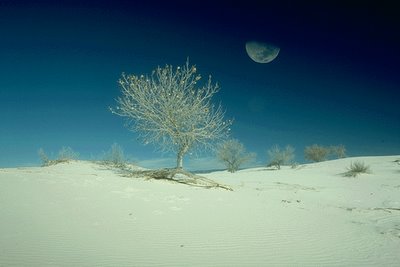
[Desert Rain, copyright by Skins Gallery]
Rain, rain, glorious rain! For liquid life falling from the sky, I am grateful beyond measure. More than 130 days without rain have come to an end.
What are you grateful for?
Offering multiple perspectives from many fields of human inquiry that may move all of us toward a more integrated understanding of who we are as conscious beings.

Pathways: Why does Spirit bother to manifest at all, especially when that manifestation is necessarily painful and requires that It become amnesiac to Its true identity? Why does God incarnate?There you have it. The Ken has spoken.
Ken Wilber: Oh, I see you’re starting with the easy questions. Well, I’ll give you a few theoretical answers that have been offered over the years, and then I’ll give you my personal experience, such as it is.
I have actually asked this same question of several spiritual teachers, and one of them gave a quick, classic answer: “It’s no fun having dinner alone.”
That’s sort of flip or flippant, I suppose, but the more you think about it, the more it starts to make sense. What if, just for the fun of it, we pretend -- you and I blasphemously pretend, just for a moment -- that we are Spirit, that Tat Tvam Asi? Why would you, if you were God Almighty, why would you manifest a world? A world that, as you say, is necessarily one of separation and turmoil and pain? Why would you, as the One, ever give rise to the Many?
Pathways: It’s no fun having dinner alone?
Ken Wilber: Doesn’t that start to make sense? Here you are, the One and Only, the Alone and the Infinite. What are you going to do next? You bathe in your own glory for all eternity, you bask in your own delight for ages upon ages, and then what? Sooner or later, you might decide that it would be fun -- just fun -- to pretend that you were not you. I mean, what else are you going to do? What else can you do?
Pathways: Manifest a world.
Ken Wilber: Don’t you think? But then it starts to get interesting. When I was a child, I used to try to play checkers with myself. You ever tried that?
Pathways: Yes, I remember doing something like that.
Ken Wilber: Does it work?
Pathways: Not exactly, because I always knew what my “opponent’s” move was going to be. I was playing both sides, so I couldn’t “surprise” myself. I always knew what I was going to do on both sides, so it wasn’t much of a game. You need somebody “else” to play the game.
Ken Wilber: Yes, exactly, that’s the problem. You need an “other.” So if you are the only Being in all existence, and you want to play -- you want to play any sort of game -- you have to take the role of the other, and then forget that you are playing both sides. Otherwise the game is no fun, as you say. You have to pretend you are the other player with such conviction that you forget that you are playing all the roles. If you don’t forget, then you got no game, it’s just no fun.
 Following the Magician in the Tarot, we come to the High Priestess, sometimes also known as the Popess. In the popular Rider-Waite deck, she is depicted as young, austere, robed as one might find an actual pope. She sits between the Pillars of Solomon, each column marked with a letter. The precise meaning of the letters is a mystery, but some have speculated on their origin. In general, it is common to mark the opening to a temple with two pillars in order to form a threshold, a demarcation of sacred space. This element is crucial to nearly all depictions of the card.
Following the Magician in the Tarot, we come to the High Priestess, sometimes also known as the Popess. In the popular Rider-Waite deck, she is depicted as young, austere, robed as one might find an actual pope. She sits between the Pillars of Solomon, each column marked with a letter. The precise meaning of the letters is a mystery, but some have speculated on their origin. In general, it is common to mark the opening to a temple with two pillars in order to form a threshold, a demarcation of sacred space. This element is crucial to nearly all depictions of the card. The Osho Zen version of the card is called Inner Voice. This seems to suggest a passive openness to the Truth that can move through us and provide direction.
The Osho Zen version of the card is called Inner Voice. This seems to suggest a passive openness to the Truth that can move through us and provide direction.If you have found your truth within yourself there is nothing more in this whole existence to find. Truth is functioning through you. When you open your eyes, it is truth opening his eyes. When you close your eyes, it is truth who is closing its eyes.The Osho Zen view feels to me like a variation on the idea of involution, which approaches the card's depth. They further suggest that the Inner Voice acts as an oracle:
It is like an oracle who only speaks the truth. If it had a face, it would be like the face at the center of this card - alert, watchful, and able to accept both the dark and the light, symbolized by the two hands holding the crystal. The crystal itself represents the clarity that comes from transcending all dualities.This gets close to the older meanings embedded in the card. Rather than the structured version of the Rider-Waite image, many newer decks allow a more free-spirited Priestess--a move that feels more congruent with her depth.
 In Jungian terms, she is anima in the male psyche, the gateway/threshold through which he must pass to access the deeper truths of the collective unconscious, which she guards in her role as High Priestess. Similarly, the Magician is also animus or Eros in the female psyche, representing the male energy that Jung felt women must integrate as part of the individuation process. In this sense, the Magician and the High Priestess work as the balancing aspects in the psyche.
In Jungian terms, she is anima in the male psyche, the gateway/threshold through which he must pass to access the deeper truths of the collective unconscious, which she guards in her role as High Priestess. Similarly, the Magician is also animus or Eros in the female psyche, representing the male energy that Jung felt women must integrate as part of the individuation process. In this sense, the Magician and the High Priestess work as the balancing aspects in the psyche. At birth, we have within us the seeds that can release us from the ego bonds that we must develop to mature in manifest form. As we move through the cards that follow, these seeds will grow more rooted in this realm, but they will never lose their source in pure Spirit. If we let them, they will one day guide us back in our journey to fully manifest Spirit beyond the limitations of ego.
At birth, we have within us the seeds that can release us from the ego bonds that we must develop to mature in manifest form. As we move through the cards that follow, these seeds will grow more rooted in this realm, but they will never lose their source in pure Spirit. If we let them, they will one day guide us back in our journey to fully manifest Spirit beyond the limitations of ego.


Gallup summarized it this way: "Surveys repeatedly show that a substantial portion of Americans do not believe that the theory of evolution best explains where life came from." They are "not so quick to agree with the preponderance of scientific evidence."
Support for this Bible view rises steadily with age: from 43% for those 18 to 29, to 59% for those 65 and older. It declines steadily with education, dropping from 58% for those with high school degrees to a still-substantial 25% with postgraduate degrees.Gallup has been asking this in various ways since 1982, and has found support for the statement that "God created man in present form" to be 45 percent or higher each year.
Newport wraps it up: "Several characteristics correlate with belief in the biblical explanation for the origin of humans. Those with lower levels of education, those who attend church regularly, those who are 65 and older, and those who identify with the Republican Party are more likely to believe that God created humans 'as is,' than are those who do not share these characteristics."
Be afraid. Be very afraid. These people vote.


Absolute Spirit is the fundamental reality. But in order to create the world, the Absolute manifests itself, or goes out of itself--in a sense, the Absolute forgets itself and empties itself into creation (although never really ceasing to be itself). Thus the world is created as a "falling away" from Spirit, as a "self-alienation" of Spirit, although the Fall is never anything but a play of Spirit itself.-Ken Wilber, The Marriage of Sense and Soul

Ghazal 2133
wake up, wake up
this night is gone
wake up
abandon abandon
even your dear self
abandon
there is an idiot
in our market place
selling a precious soul
if you doubt my word
get up this moment
and head for the market now
don’t listen to trickery
don’t listen to the witches
don’t wash blood with blood
first turn yourself upside down
empty yourself like a cup of wine
then fill to the brim with the essence
a voice is descending
from the heavens
a healer is coming
if you desire healing
let yourself fall ill
let yourself fall ill
On Finding the Tree of Life
After Genesis 3: 22-23
If there is an outside out there
one should go out to try to find it.
This I did. There is a garden world
out there, with birds, trees, and the tree
they call The Tree of Life. The birds
avoid it, naturally. The bunched of red
berries are intact except for one bunch. It's
partly eaten. The spoor around the tree
is old, but it would indicate that some
stupid godforsaken human or beast
had staggered around and crawled away
in the first agonies of immortality.
It's too bad for it, whoever it is
and will be: our own deaths are bad enough.
Alan Dugan was born February 12, 1923, in Brooklyn, New York, and grew up in Jamaica, Queens. He began his undergraduate education at Queens College in 1941, but after two years he was drafted into the Army Air Forces. He resumed his studies at Olivet College and received a B.A. from Mexico City College in 1949. For the next ten years, Dugan held various jobs in advertising, publishing and medical supply in New York City while he began his career as a poet.
Dugan's volumes of poetry include Poems Seven: New and Complete Poetry (Seven Stories Press, 2001), winner of the National Book Award; Poems Six (1989); Poems Five: New and Collected Poems (1983), Poems 4 (1974); Collected Poems (1969); Poems 3 (1967); Poems 2 (1963); and Poems (1961), selected for the Yale Series of Younger Poets and winner of the National Book Award and a Pulitzer Prize. He has also received the Levinson Award from Poetry magazine, the Prix de Rome from the American Academy of Arts and Letters, and fellowships from the Guggenheim Foundation and the Rockefeller Foundation.
Dugan was a member of the faculty of the Fine Arts Work Center in Provincetown, Massachusetts, and lived in Truro. He died of pneumonia on September 3, 2003.
When he learned that his first book would be published by the Yale Series of Younger Poets, he was working for a physiological-model manufacturer making plastic vaginas that showed doctors’ patients how to properly insert diaphragms.
Poem
After your first poetry reading
I shook hands with you
and got a hard-on. Thank you.
We know that old trees
can not feel a thing
when the green tips burst
through the tough bark in spring,
but that's the way it felt,
that's the Objective Correlative
between us poets, love:
a wholly unexpected pain
of something new breaking out
with something old about it
like your new radical poems
those audible objects of love
breaking out through nerves
as you sweated up on stage,
going raw into painful air
for everyone to know.
On Looking for Models
The trees in time
have something else to do
besides their treeing. What is it.
I'm a starving to death
man myself, and thirsty, thirsty
by their fountains but I cannot drink
their mud and sunlight to be whole.
I do not understand these presences
that drink for months
in the dirt, eat light,
and then fast dry in the cold.
They stand it out somehow,
and how, the Botanists will tell me.
It is the "something else" that bothers
me, so I often go back to the forests.